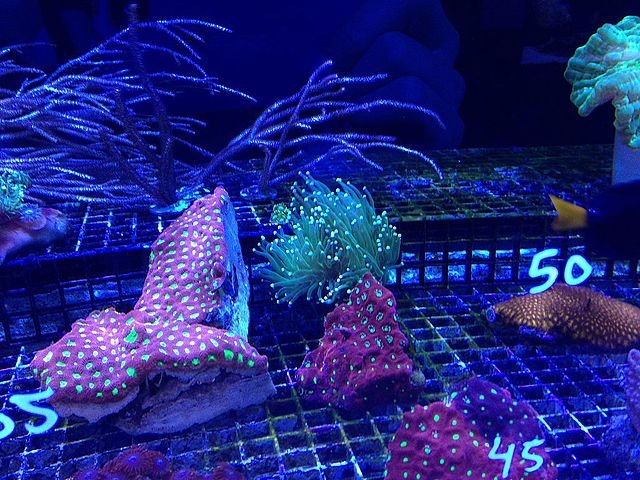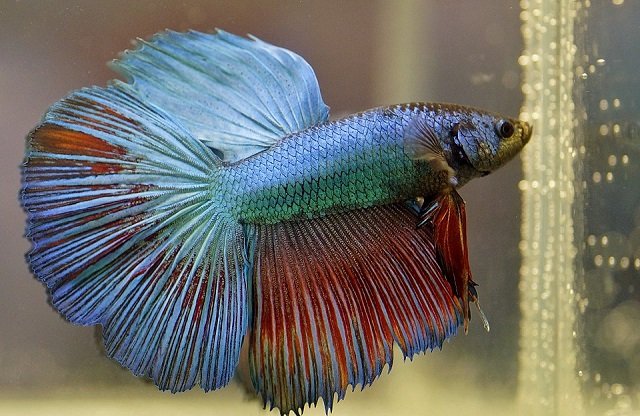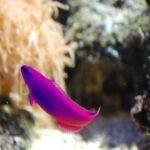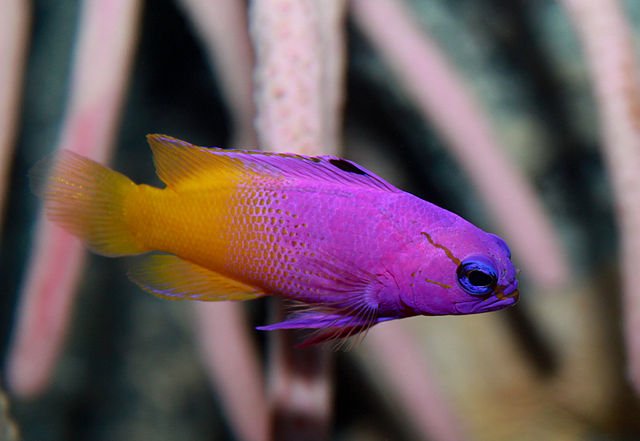
The Royal Gramma fish (Gramma loreto), also known as the fairy basslet or loreto basslet, is one of the most popular species in marine aquariums due to its stunning coloration and relatively peaceful nature. With its body divided into two vibrant colors—purple in the front and bright yellow in the rear—this small yet striking fish is an excellent choice for any reef enthusiast.
This fish belongs to the Grammatidae family and is native to the Caribbean Sea, where it inhabits coral reefs and rocky crevices. Its size, resilience, and ease of adaptation make it one of the best choices for saltwater aquariums, especially for beginners.
In this article, we will cover everything you need to know about the Royal Gramma fish, including its care, feeding, and compatibility with other fish. Let’s get started!
What are the characteristics of the Royal Gramma?
- 1 What are the characteristics of the Royal Gramma?
- 2 Natural habitat of the Royal Gramma Fish
- 3 Aquarium conditions for Royal Gramma care
- 4 What does the Royal Gramma fish eat? Feeding and nutrition
- 5 Captive breeding of the Royal Gramma
- 6 Compatibility of the Royal Gramma with other fish
- 7 Common Diseases
- 8 Frequently Asked Questions (FAQ)
- 9 Conclusion
- 10 References
- 11 Entradas relacionadas:
Taxonomy
- Kingdom: Animalia
- Phylum: Chordata
- Class: Actinopterygii
- Order: Perciformes
- Family: Grammatidae
- Genus: Gramma
- Species: Gramma loreto (Poey, 1868)
- Common names in Spanish: Pez abuela real, royal gramma, loreto, merito rabirrubio, Abuela loreto
- Common names in English: Royal gramma, basslet royal gramma, fairy basslet
Physical characteristics
The Royal Gramma fish is relatively small. Most specimens reach a maximum size of about 8 cm (3 inches) and rarely exceed this length. In a well-maintained aquarium, the Royal Gramma typically lives between 5 to 6 years, though some individuals may live even longer.
- Body divided into two colors: Bright purple in the front and intense yellow in the rear.
- A dark line runs across the eye.
- A small black dot on the dorsal fin.
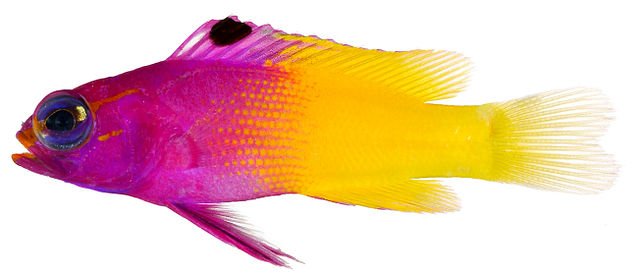
Natural habitat of the Royal Gramma Fish
The Royal Gramma fish is native to the tropical waters of the Caribbean Sea, found in countries such as the Bahamas, Bermuda, the Lesser Antilles, and regions like Central America and northern South America (Venezuela, Colombia). It has also been introduced in some areas outside its natural range, such as Florida.
It prefers caves, overhangs, and crevices in coral reefs, often in areas with strong currents. It is typically found at depths ranging from 1 to 40 meters (Santos et al., 2011), though it can be found as deep as 60 meters.
In the past decade, predation by the invasive lionfish (Pterois volitans) has increased the mortality of Royal Gramma fish (Gramma loreto), contributing to the local extinction of some populations (Ingeman, 2016).
Aquarium conditions for Royal Gramma care
One of the most important aspects of Royal Gramma fish care is providing a suitable environment. Despite their small size, they require ample space with plenty of hiding spots to reduce stress and prevent conflicts with other fish.
Stay Always Informed
Join our communities to instantly receive the most important news, reports, and analysis from the aquaculture industry.
Table 01. Minimum parameters for the care of the Royal Gramma fish (Gramma loreto) in an aquarium.
| Parameter | Range |
|---|---|
| Tank Size | Minimum recommended: 115 liters (30 gallons) for one fish. Ideal: 190 liters (50 gallons) if housed with other fish. Groups: 284 liters (75 gallons). |
| Water Temperature | 22-27°C (72-78°F) |
| Water pH | 8.1 – 8.4 |
| Salinity | 1.020 – 1.025 |
| Water Hardness | 8-12 dKH |
| Nitrates | < 20 ppm |
| Water Flow | Moderate |
| Photoperiod | 12L:12D (light:dark) |
It is advisable to install artificial caves or rocky structures in the aquarium to simulate their natural habitat and provide hiding places. Dim lighting is recommended, as they are accustomed to living in caves in the wild.
What does the Royal Gramma fish eat? Feeding and nutrition
The Royal Gramma is a carnivorous fish that, in nature, feeds on small crustaceans, zooplankton, and the larvae of other fish. In captivity, its diet should be varied to maintain its vibrant color and strong immune system.
Santos et al. (2011) describe the feeding habits of the Royal Gramma fish (Gramma loreto) at different life stages:
Adult feeding
In their natural habitat, Gramma loreto are carnivorous and feed on small free-living crustaceans. In captivity, adults primarily feed on newly hatched Artemia, provided three to four times a day. This diet is alternated with a portion of live or frozen mysids three times per week.
They can also be given pelleted food, alternating it with Artemia and mysid diets. The pellets should contain between 50-60% protein and 9-31% lipids, as well as carotenoids to maintain their coloration.
It is recommended to feed them 1-2 times a day in small portions.
Larval feeding
Feeding larvae requires special care due to their small mouth size and specific nutritional needs.
Researchers recommend providing live food, such as microalgae (Isochrysis galbana and Nannochloropsis sp.) and rotifers (Brachionus plicatilis) at a density of 5-10 rotifers per mL. Larvae should be fed four times a day.
A feeding protocol for larval rearing may include:
- Rotifers at a concentration of 10-15 rotifers/mL
- After 10 days, newly hatched Artemia nauplii should be added
- At 18 days, enriched Artemia nauplii should be introduced, and rotifers should be discontinued
- Once the juveniles grow larger, they can gradually transition to flake or pelleted diets
Captive breeding of the Royal Gramma
Challenges in sex identification
Breeding the Royal Gramma fish (Gramma loreto) is more complex compared to other marine fish species, mainly due to the lack of sexual dimorphism, which makes it difficult to distinguish males from females. However, in captivity, they can reproduce year-round (Cid, 2024).
These fish are protogynous hermaphrodites, meaning they are born female and can change to male if necessary. Pastor and Báez (2002) reported that sexual maturity occurs at a size class of 35-40 mm in females and 55-60 mm in males.
Aquarium preparation
To initiate the breeding process, it is necessary to prepare the aquariums and select and identify the breeding pairs, which should be housed separately in breeding tanks.
Tank setup recommendations:
- The tanks should be darkened, with only a small viewing window
- A 2 cm layer of crushed shells or gravel should be placed at the bottom for nest-building
- Tanks should be covered to prevent escapes
Selection criteria
- Fish larger than 3.5 cm should be selected, as they are considered sexually mature
- Pairs can be chosen based on size, assuming that males are larger than females
Vacco et al. (2021) reported that in small tanks (23 L), a sex ratio of 1 male per 2 females (1M:2F) appears to be optimal for spawning. In this setup, males exhibit more courtship behavior, spend more time in their nests, and show increased nest protection compared to other sex ratios (1M:1F and 1M:3F).
Courtship and spawning
Courtship begins with the male persistently staying close to the female and exhibiting mild aggressive behaviors without harming her. The male then builds a nest in a cave or crevice, using algae and other materials.
Spawning typically occurs at dawn or dusk. The male guards the eggs, which measure 1 mm in diameter, until they hatch in 10-11 days at a temperature of 23-27°C (Asoh & Yoshikawa, 1996).
Eggs
The eggs are about 1 mm in diameter and form a clump attached to the nest materials. They should be monitored for fertilization by observing black dots (larval eyes). The eggs are transferred to an incubator after 8-10 days (Santos et al., 2011).
Incubation
For egg incubation and larval collection, Santos et al. (2011) used two systems:
- Open system: A 25L darkened tank with a 200µm mesh filter on the outlet tube
- Closed system: A water storage tank equipped with a thermostat and a water pump
Larval rearing
Newly hatched larvae are tiny and difficult to feed. According to Asoh and Yoshikawa (1996), newly hatched larvae have a small yolk sac and a total length of 2.9-3.8 mm. The larvae of G. loreto have a simple morphological development, with few specializations for pelagic life (Leis et al., 2012).
It is crucial to monitor larval health after hatching. Daily siphoning of the incubator bottom is necessary, along with frequent checks of physicochemical parameters.
Newly hatched larvae are at risk of being eaten by their own parents, indicating cannibalistic behavior. To prevent this, the nest should be removed and placed in a protected system to ensure larval survival.
Compatibility of the Royal Gramma with other fish
Gramma loreto are known for their peculiar habit of swimming with their belly oriented towards the nearest surface, whether it be the substrate, a rock, or even the aquarium glass. This means they are often seen swimming upside down or at strange angles. This behavior is completely normal and should not be a cause for concern. It is their way of orienting themselves in their natural environment of caves and overhangs.
They can also be territorial, especially with other fish of similar appearance or those competing for the same resources. However, their aggression is usually limited to short chases and rarely causes harm.
If you notice that your Royal Gramma is hiding excessively or changing color, it could be stressed due to inadequate water conditions or the presence of aggressive fish.
The Royal Gramma Basslet is generally peaceful but can become territorial if not provided with enough hiding spots.
Good Tank Mates:
Bad Tank Mates:
- Dottybacks (can be aggressive)
- Lionfish
- Hawkfish
- Large and aggressive fish
If introducing it into a tank with other fish, it is best to do so after the more territorial fish to avoid conflicts.
Common Diseases
White spot disease (Ich)
Santos et al. (2011) reported that Ich or white spot disease, caused by Cryptocaryon irritans, affects the gills, fins, and skin of the Royal Gramma fish. The infection is associated with stress, handling, temperature fluctuations, and high levels of organic load.
White spot disease is treated with formalin and water changes.
Frequently Asked Questions (FAQ)
Is the Royal Gramma reef-safe?
Yes, the Royal Gramma is considered reef-safe. It does not usually bother corals or other invertebrates.
Does my Royal Gramma fish need an anemone?
No, Royal Grammas do not need an anemone. They are rock dwellers and prefer hiding in caves and crevices.
Why is my Royal Gramma hiding all the time?
It is normal for Royal Grammas to be shy, especially at first. Ensure they have enough hiding spots and that there are no aggressive fish in the aquarium.
Is my Royal Gramma fish sick if it changes color?
Mild color changes can be normal and may be related to stress, mood, or social hierarchy. However, a drastic color change, especially if accompanied by other symptoms (such as loss of appetite, frayed fins, or white spots), may indicate illness.
Can I keep multiple Royal Grammas together?
This is only recommended in large tanks (over 75 gallons) and if they are introduced at the same time. Otherwise, territorial fights are likely.
What should I do if my Gramma loreto is hiding and not eating?
First, check that water parameters are correct. A change in water quality can cause fish to hide and stop eating. If the parameters are fine, look for signs of disease, such as white spots, frayed fins, or labored breathing. If there are no signs of illness, the fish may be stressed due to other tank inhabitants or a lack of hiding spots.
Conclusion
The Royal Gramma fish is a spectacular and relatively easy-to-care-for addition to any marine aquarium. Its vibrant coloration, interesting behavior, and reef compatibility make it a popular choice among aquarists. With proper care, this small fish can thrive and provide years of enjoyment. By following the tips in this guide, you can create the ideal environment for your Gramma loreto and enjoy its beauty and unique personality.
References
Asoh, K., & Yoshikawa, T. (1996). Nesting behavior, male parental care, and embryonic development in the fairy basslet, Gramma loreto. Copeia, 1-8.
Cid Ruiz José Mª. 2024. Gramma loreto. Una experiencia reproductiva en acuario. Asociación Española de Acuaristas. Revista Argos No 29: 20 p.
Ingeman Kurt. (2016) Lionfish cause increased mortality rates and drive local extirpation of native prey. Mar Ecol Prog Ser 558:235-245. https://doi.org/10.3354/meps11821
Leis, Jeffrey; Bullock, S; Duday, A; Guion, C; Galzin, R (2012). Development of morphology and swimming in larvae of a coral-reef fish, the royal gramma, Gramma loreto (Grammatidae: Teleostei). University of Tasmania. Journal contribution.
Pastor Gutiérrez, L., & Báez Hidalgo, M. (2002). Reproducción y alimentación del Loreto Gramma loreto Poey, 1868 (Pisces, Grammidae), en la Costa Norte de La Habana, Cuba. Revista de investigaciones marinas, 23(3), 195-201.
Santos-Acevedo Marisol, Gloria Helena Ospina-Salazar, Johann López-Navarro, Sofía Sepúlveda-Cárdenas y Javier Gómez-León. 2011. Contribución a la biología y mantenimiento de peces marinos ornamentales: Usos potenciales de la biodiversidad. Serie de publicaciones generales No. 47. Santa Marta, 160 pág. ISBN: 978-958-8448-38-1
Vacco, V., Litvinoff, E., Camacho, C., Guinovart, C., & Anderson, P. (2021). Establishing optimal broodstock sex ratios for the royal gramma (Gramma loreto) in small scale system aquaculture. Aquaculture, 543, 736931. https://doi.org/10.1016/j.aquaculture.2021.736931
Editor at the digital magazine AquaHoy. He holds a degree in Aquaculture Biology from the National University of Santa (UNS) and a Master’s degree in Science and Innovation Management from the Polytechnic University of Valencia, with postgraduate diplomas in Business Innovation and Innovation Management. He possesses extensive experience in the aquaculture and fisheries sector, having led the Fisheries Innovation Unit of the National Program for Innovation in Fisheries and Aquaculture (PNIPA). He has served as a senior consultant in technology watch, an innovation project formulator and advisor, and a lecturer at UNS. He is a member of the Peruvian College of Biologists and was recognized by the World Aquaculture Society (WAS) in 2016 for his contribution to aquaculture.
